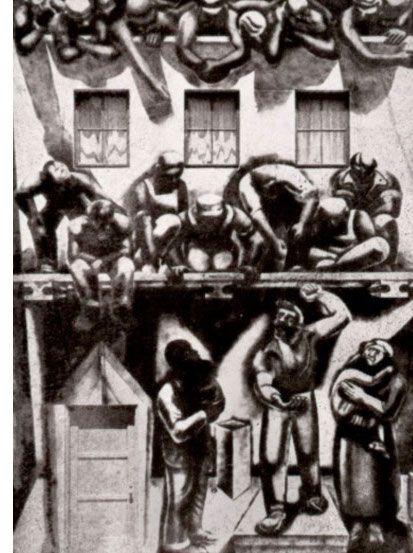The scene is interrupted by the intrusion of a pair of shoes behind his own; they belong to a friendly-looking man* who reaches around him to push his way into the building with half a glance and a polite smile. He’s already most of the way through the door once Paul finally moves to let him pass properly, and as he does so he decides that the man looks more apt to be in insurance, with a suit, a tie, and an office, than in a ragged shirt with the sleeves rolled up, shouldering his way into an art school building. He follows behind after a second, catching the door before holding it open for himself and his too-large portfolio. The leather has kept most of its integrity, but it’s still visibly well used, having been his mother’s before it was his. ‘Scholarship’ feels like a heavy word in a building already as heavy as this one. He throws a glance back out to the street as he makes his way inside, imagining that he can see the sidewalk buckling and folding under the collective weight.
He follows the directions given to him by the woman at the front desk. He gets lost anyway, passing through outdoor courtyards and up strange, modern looking staircases, and so he doubles back. In doing so, he passes the mural his mother had told him to look out for; ‘Workers Meeting,’ Siqueiros’ project from the year before.
*Millard Sheets (June 24, 1907 – March 31, 1989).
Artist, teacher, muralist, architectural designer.
One of the founding members of the California Water Color Society, Sheets exerted a huge influence over the artistic landscape of California and beyond during the course of his career.
Sheets himself graduated from Chouinard in 1929, by which point he had already been instructing at the school for a number of years. He continued teaching at Chouinard and other institutions into the early 1930s.
Around this time, Sheets travelled to Europe using prize money from an art competition in Texas, wherein he came into contact with contemporary European art and, specifically, met French artist Henri Matisse.
Sheets had in turn studied under both Tobias Hinkle and Frank Tolles Chamberlin, who had been a founding member of the Chouinard Art Institute.

Paul imagines the painting in the future, covered over or knocked down. The sun hits the crown of his head in the courtyard, and he looks to see the cracks which must already be forming under the intense heat. He can’t make any out.
He walks through the door in the mural and into the building behind.
...
Orange Pickers and History of Upland would be Julian’s last public mural projects. In 1939, he started work at the Leon Schlesinger animation studio, later to become Warner Brothers Cartoons. Initially, he worked as a background painter in Chuck Jones’ production unit. Jones himself was a fellow Chouinard alumni, along with his layout artist at the time, John McGrew. Already somewhat established as an artist in his own right, Julian now had to cut his teeth as a painter for the specific purpose of cel animation backgrounds.